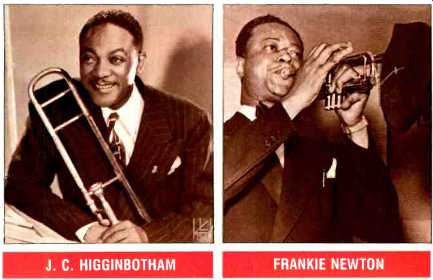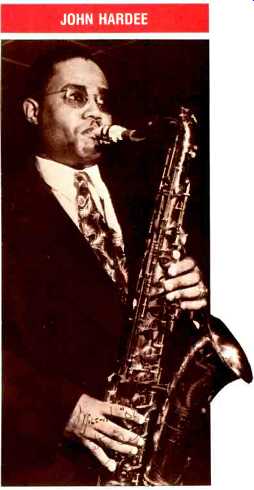By Frank Driggs

above: GERRY MULLIGAN
Mosaic Records is bringing back to life a great deal of wonderful jazz that has not been available for quite a long time. Founders Charles Lourie and Michael Cuscuna--two seasoned marketing and production men with lots of experience in big and small record companies--have long-term leases on the old Blue Note and World Pacific catalogs; they also plan to lease significant con temporary material from a variety of sources.
The Connecticut-based company, founded in California in 1983, is pack aging this music the way it should be: Reissued material is arranged in chronological sequence, along with alternate takes and previously unissued tunes used in toto, wherever and whenever possible. The packaging, liner notes, discographies, mastering, and pressing represent the state of the art for this kind of material. The only flaw I can find in their superb presentations is one I had to overcome more than 20 years ago, when I produced a somewhat similar series of packages at Columbia Records: There is no listing of contents on the backs of the boxes; this may prove to be a serious drawback for those who may not know the material well.
Still, the series is a remarkable accomplishment and an extremely valuable one. Mosaic has set a standard for the industry to follow, and we can look forward to more marvelous music in the months and years to come.
(Editor's Note: The following reviews are of Mosaic's first seven releases; several additional packages are avail able. All may be ordered from Mosaic Records, 197 Strawberry Hill Ave., Stamford, Conn. 06902; 203-327-7111. Prices quoted do not include shipping and handling.)
-----------------
The Complete Blue Note Thelonious Monk (MR4-101, four-record set, $34), a limited edition of 7,500 pressings, contains all the known recordings--as well as a considerable number of previously unissued alternate takes--which Monk made as a leader for Blue Note from 1947 through 1952. One of the great originals of jazz, Thelonious Sphere Monk had a sound so unique that he carved out his own niche while being wrongly regarded as a be-bopper. Generally, the sessions with just Monk and rhythm come off best, be cause horn players seem to have inordinate difficulty getting his rhythms in place. Not that there is any really bad playing, but Monk is such a whole, in and of himself, that horns are almost (to me, anyway) an intrusion upon his creations. There is some fine playing by Sahib Shihab on alto, Billy Smith on tenor, Milt Jackson on vibes, Lou Donaldson on alto saxophone, Lucky Thompson on tenor sax, Kenny Dorham on trumpet, and finally, by Sonny Rollins on his own date in 1957, with Monk as a sideman. There is wonderful accompaniment throughout, particularly by Art Blakey and a little-known bassist named Bob Paige.

-------- MEADE "LUX" LEWIS (LEFT) AND ALBERT AMMONS
The Original Gerry Mulligan Quartet with Chet Baker (MR5-102, five-record set, $42.50) contains all the justifiably famous recordings which Mulligan's pianoless group made with Baker in 1952 and 1953. These records, as Pete Welding's extremely thorough and fascinating notes tell us, made Mulligan a media celebrity, made Chet Baker a major trumpet star at a time when Miles Davis was in eclipse, and pretty much launched Pacific Jazz as a record label. Their music was, for better or worse, also dubbed West Coast jazz. The hard-swinging and gifted Mulligan took great exception to this description, having performed superbly in a wide variety of contexts on both coasts before and after these history-making sessions, some of which were originally recorded for Capitol, others for Pacific Jazz. The last three sessions (including one live from The Haig, a Los Angeles club where the group made its initial impact) include some of the very best Lee Konitz alto saxophone work to be found on record.
"Bernie's Tune," "Walkin' Shoes," "Freeway," and so many other completely realized improvisations are all here, and sound to this listener's ears completely fresh and just as exciting as they were when originally released. Fourteen previously unissued performances also help make this Mosaic package absolutely essential.
-----------------
The Complete Blue Note Albert Ammons and Meade Lux Lewis (MR3-103, three-record set, $25.50) may well have less appeal than most of Mosaic's other releases. This would be a great shame, because solo boogie woogie piano as played by Ammons and Lewis, two of the genre's very best practitioners, is really no longer being performed. Yes, Sammy Price is still around, and quite capable in this style, but this was a specialty of both these players, in a time when boogie-woogie, believe it or not, achieved a national reputation of a sort. Although Ammons and Lewis recorded for many other companies in the 1940s, it was for Alfred Lion at Blue Note that they did their best work. Lion had them make extended recordings on 12-inch 78s very expensive, in a time when few collectors knew or understood any thing about boogie-woogie or Ammons and Lewis.
Ammons specialized in hard-driving, medium and up-tempo pieces. Lewis was adept at songs of all tempos, but none more so than the slow, introspective "Blues Parts I Through V," the last part of which was not released until this Mosaic package was produced.
The complexity of Lewis' playing and the sheer joy and drive of Ammons' work really come across. It's the real thing, not the imitation done by every big band and then every R&B and rock group of the past 30 years. This set is essential to anyone wanting to know the beauty and joy of this very special branch of jazz and blues.

----CLIFFORD BROWN, CHET BAKER
--------------
The Complete Blue Note and Pacific Jazz Recordings of Clifford Brown (MR5-104, five-record set, $42.50) lets the listener know right from the start that a particularly gifted player had arrived on the scene. Clifford Brown was, at 23, the most promising of all modern jazz men to come up since the advent of the LP. He had it all-speed, articulation, ideas, a fine glowing tone, and tremendous punch to his playing. His death at age 25 in an auto accident was a tragic loss to music. He is heard here at length in the company of proven talents like Lou Donaldson, Elmo Hope, J. J. Johnson, Horace Silver and Jimmy Heath, with stellar rhythm sections headed by Kenny Clarke, Art Blakey and Phifly Joe Jones. There is no question of the value of this music and of Clifford Brown's unique talent.

--------ART PEPPER
The Complete Pacific Jazz Small Group Recordings of Art Pepper (MR3 105, three-record set, $25.50). Much of Art Pepper's life was lived in the shadows, as he tried to deal with drug ad diction, long incarceration and a general inability to come to grips with the world away from jazz. Luckily for us, he left a large legacy of beautiful music behind. Mosaic's beautifully pack aged, mastered, and annotated set will very definitely stand as the tribute to Art Pepper's highly individualistic alto-saxophone solos. Recorded in 1956, with one date in 1957, the set starts off deceptively low-key, with Chet Baker and Richie Kamuca and some of the antsiest piano I've ever heard from Pete Jolly. Later things improve considerably, with Baker playing some of his very strongest solos and Phil Urso contributing some good tenor. Pepper shares the last dates with Bill Perkins and Bill Holman on tenor (both of whom play very well), with some good trumpet by Don Fagerquist, tuba by Red Callender and baritone by Bud Shank. And there is some excellent drumming throughout the set by Stan Levey, Lawrence Marable, Mel Lewis, and Shelly Manne.
------------
The Complete Blue Note Forties Recordings of Ike Quebec and John Hardee (MR4-107, four-record set, $34).
Quebec and Hardee were two of swing's noncommissioned officers, jazz soldati of a high order. Their talents were put to the test time and time again during and after World War II, and the two enjoyed a measure of success in the '40s, only to be shot down in the overwhelming tide of public indifference to their consummate skills to ward the end of the decade. It was an exciting time for modern jazz, but a very bad time for those in other genres, including many artists who had been major stars.
Both saxophonists were born in 1918. Quebec, from Newark, N.J., scored first because of his proximity to New York, where all the action was; he worked with a dozen big and small bands before settling in with Cab Calloway's band in 1944. He signed with Blue Note that year and immediately had a major Harlem jukebox hit with "Blue Harlem," both takes of which were originally released. As long as Quebec remained with Calloway, he had a steady paycheck, but he most certainly deserved personal stardom, although he never achieved it on his own. John Hardee, from Corsicana, Tex., served his apprenticeship in local and territory bands before going into the service in World War II. He surfaced in Tiny Grimes' group on 52nd Street in New York and was added to Blue Note's roster in 1946. His first record, "Tired" backed with "Blue Skies," sold very well throughout the New York area, and in 1948 Hardee formed his own quartet. After a year, there was just not enough work to keep going, and late it 1949, at his wife's urging, he went back to Dallas and became a music teacher.
Both men have left a fine legacy of big-toned, warm, and swinging saxophone solos that Blue Note captured in the 1944-46 period. All are very much recommended as outstanding examples of the kind of playing that, for inexplicable reasons, fell into disfavor in the late '40s. Besides the two saxists, Jonah Jones, Tyree Glenn, Buck Clayton Tiny Grimes, Ram Ramirez, Sid Catlett and J. C. Heard all have prominent roles to play here, in some of swing's last and finest moments on
----------------
The Complete Recordings of the Port of Harlem Jazzmen (MR1-108, $8.50) gathers Blue Note's first two 1939 sessions built around Frankie Newton and J. C. Higginbotham, with Sidney Bechet added on the second session. Piano is by Albert Ammons on the first and Meade Lux Lewis on the second and a rhythm team of Teddy Bunn, Johnny Williams and Sid Catlett round out the picture. There is fine playing, particularly by Frankie New ton, a trumpeter of real ability whose lengthy illnesses prevented him from realizing himself on records the way he might have. J. C. Higginbotham had been a major force on trombone since his days with Luis Russell in 1929, and he is still near the top of his form on "Basin Street Blues" and "Wearyland Blues," included here. Newton is at his peak on "Blues for Tommy," dedicated to the great New Orleans trumpeter Tommy Ladnier, who had passed away four days before the session, and who, according to Stanley Dance's lu cid notes, may well have been producer Alfred Lion's first choice to make this date. Sidney Bechet stars on "Summertime" in a classic performance which may well be taken for granted now; in 1939 it was highly unusual and quite daring, and was Blue Note's first major hit.
Because these were the first combo records made by Blue Note, they have a slightly tentative quality to them. Newton, Higgy, and Bechet are clearly the stars and the principal reason one would want to own this record.

IKE QUEBEC

J. C. HIGGINBOTHAM; FRANKIE NEWTON

JOHN HARDEE
(Audio magazine, Jun. 1986)
Also see:
Inscriptions--Miles Davis on CD (Apr. 1988)
= = = =